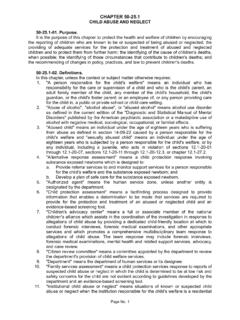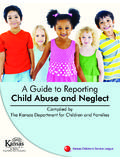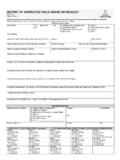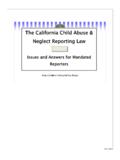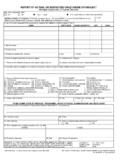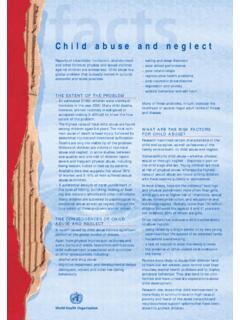Transcription of CHAPTER 3 Child abuse and neglect by parents and other ...
1 CHAPTER 3 Child abuse and neglectby parents and other caregiversBackgroundChild abuse has for a long time been recorded inliterature, art and science in many parts of theworld. Reports of infanticide, mutilation, abandon-ment and other forms of violence against childrendate back to ancient civilizations (1). The historicalrecord is also filled with reports of unkempt, weakand malnourished children cast out by families tofend for themselves and of children who have beensexually a long time also there have existed charitablegroups and others concerned with children s well-being who have advocated the protection ofchildren. Nevertheless, the issue did not receivewidespread attention by the medical profession orthe general public until 1962, with the publicationof a seminal work,The battered Child syndrome,byKempe et al.
2 (2).The term battered Child syndrome was coinedto characterize the clinical manifestations of seriousphysical abuse in young children (2). Now, fourdecades later, there is clear evidence that Child abuseis a global problem. It occurs in a variety of formsand is deeply rooted in cultural, economic andsocial practices. Solving this global problem,however, requires a much better understandingof its occurrence in a range of settings, as well as ofits causes and consequences in these are Child abuse and neglectdefined?Cultural issuesAny global approach to Child abuse must take intoaccount the differing standards and expectations forparenting behaviour in the range of cultures aroundthe world. Culture is a society s common fund ofbeliefs and behaviours, and its concepts of howpeople should conduct themselves.
3 Included inthese concepts are ideas about what acts of omissionor commission might constitute abuse and neglect (3, 4). In other words, culture helps define thegenerally accepted principles of Child -rearing andcare of cultures have different rules about whatare acceptable parenting practices. Some researchershave suggested that views on Child -rearing acrosscultures might diverge to such an extent thatagreement onwhatpractices areabusive orneglectfulmay be extremely difficult to reach (5, 6). None-theless, differences in how cultures define what isabusive have more to do with emphasizing particularaspects of parental behaviour. It appears that there isgeneral agreement across many cultures that childabuse should not be allowed, and virtual unanimityin this respect where very harsh disciplinary practicesand sexual abuse are concerned (7).
4 Types of abuseThe International Society for the Prevention of ChildAbuse and neglect recently compared definitions ofabuse from 58 countries and found some common-ality in what was considered abusive (7). In 1999,the WHO Consultation on Child abuse Preventiondrafted the following definition (8): Childabuseormaltreatment constitutesallformsof physical and/or emotional ill-treatment, sexualabuse, neglect or negligent treatment or commer-cial or other exploitation, resulting in actual orpotential harm to the Child s health, survival,development or dignity in the context of arelationship of responsibility, trust or power. Some definitions focus on the behaviours oractions of adults while others consider abuse to takeplace if there is harm or the threat of harm to thechild (8 13).
5 The distinction between behaviour regardless of the outcome and impact or harm is apotentially confusing one if parental intent formspart of the definition. Some experts consider asabused those children who have been inadvertentlyharmed through the actions of a parent, whileothers require that harm to the Child be intended forthe act to be defined as abusive. Some of theliterature on Child abuse explicitly includes violenceagainst children in institutional or school settings(14 17).The definition given above (8) covers a broadspectrum of abuse . This CHAPTER focuses primarilyon acts of commission and omission by parents orcaregivers that result in harm to the Child . Inparticular, it explores the prevalence, causes andconsequences of four types of Child maltreatmentby caregivers, namely: CHAPTER 3.
6 Child abuse AND neglect BY parents AND other physical abuse ; sexual abuse ; emotional abuse ; abuse of a Child is defined as those actsof commission by a caregiver that cause actualphysical harm or have the potential for harm. Sexualabuse is defined as those acts where a caregiver usesa Child for sexual abuse includes the failure of acaregiver to provide an appropriate and supportiveenvironment, and includes acts that have an adverseeffect on the emotional health and development of achild. Such acts include restricting a Child s move-ments, denigration, ridicule, threats and intimida-tion, discrimination, rejection and other non-physical forms of hostile refers to the failure of a parent to providefor the development of the Child where the parentis in a position to do so in one or more of thefollowing areas: health, education, emotionaldevelopment, nutrition, shelter and safe livingconditions.
7 neglect is thus distinguished fromcircumstances of poverty in that neglect can occuronly in cases where reasonable resources areavailable to the family or manifestations of these types of abuse arefurther described in Box extent of the problemFatal abuseInformation on the numbers of children who dieeach year as a result of abuse comes primarily fromdeath registries or mortality data. According to theWorld Health Organization, there were an esti-mated 57 000 deaths attributed to homicide amongchildren under 15 years of age in 2000. Globalestimates of Child homicide suggest that infants andvery young children are at greatest risk, with ratesfor the 0 4-year-old age group more than doublethose of 5 14-year-olds (see Statistical annex).Theriskoffatalabuseforchildrenvar iesaccordingto the income level of a country and region of theworld.
8 For children under 5 years of age living inhigh-income countries, the rate of homicide is 000forgirls. Inlow- to middle-income countries the rates are 2 3times higher per 100 000 for boys and per100 000 for girls. The highest homicide rates forchildren under 5 years of age are found in the WHOA frican Region per 100 000 for boys and 100 000 for girls. The lowest rates are seen inhigh-income countries in the WHO European,Eastern Mediterranean and Western Pacific Regions(see Statistical annex).Many Child deaths, however, are not routinelyinvestigated and postmortem examinations are notcarried out, which makes it difficult to establish theprecise number of fatalities from Child abuse in anygiven country. Even in wealthy countries there areproblems in properly recognizing cases of infanti-cide and measuring their incidence.
9 Significantlevels of misclassification in the cause of death asreported on death certificates have been found, forexample, in several states of the United States ofAmerica. Deaths attributed to other causes forinstance, sudden infant death syndrome or acci-dents have often been shown on reinvestigationto be homicides (18, 19).Despite the apparent widespread misclassifica-tion, there is general agreement that fatalities fromchild abuse are far more frequent than officialrecords suggest in every country where studies ofinfant deaths have been undertaken (20 22).Among the fatalities attributed to Child abuse , themost common cause of death is injury to the head,followed by injury to the abdomen (18, 23, 24).Intentional suffocation has also been extensivelyreported as a cause of death (19, 22).
10 Non-fatal abuseData on non-fatal Child abuse and neglect come froma variety of sources, including official statistics, casereports and population-based surveys. Thesesources, however, differ as regards their usefulnessin describing the full extent of the statistics often reveal little about thepatterns of Child abuse . This is partly because, inmany countries, there are no legal or social systemswith specific responsibility for recording, let aloneresponding to, reports of Child abuse and neglect (7). In addition, there are differing legal REPORT ON VIOLENCE AND HEALTHBOX of Child abuse and neglectInjuries inflicted by a caregiver on a Child can take many forms. Serious damage or death in abusedchildren is most often the consequence of a head injury or injury to the internal organs.











